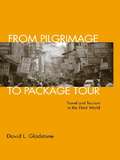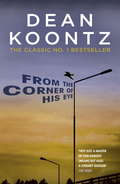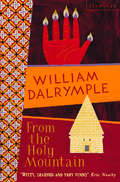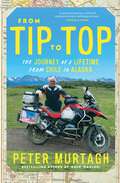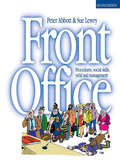- Table View
- List View
From L.A. with Love
by Cassie RoccaFor fans of Lucy Vine and Sophie Ranald, a sparkling new romance set in the City of Angels... Since leaving her home and family to move to Los Angeles, Heaven Taylor has had one goal: to become a successful journalist. But competition is fierce and Heaven's already struggling to keep her job at a gossip magazine. If she wants to succeed she'll need to beat everyone to the scoop of the day: snapping the paparazzi's favourite supermodel with her mysterious lover. Ignoring the forecasts of a terrible storm, a determined Heaven snaps the glamorous pair aboard a yacht. But then the storm breaks and poor Heaven ends up in the ocean, putting her dreams of glory – and her life – at risk. She's saved from drowning by David Cooper, who arrives aboard a white boat like a prince on his steed. Too bad, though, that despite his statuesque beauty, David is no prince – and the one person Heaven hoped she would never meet again... Cassie Rocca is a writer of Sicilian origin who has lived in Genoa since the age of three. In everyday life she is a child-minder, a job which gives her plenty of inspiration for her modern fairy tales.
From Local to Global: Eco-Entrepreneurship and Global Engagement with the Environment (Advances in the Study of Entrepreneurship, Innovation & Economic Growth #30)
by Matthew M. Mars Taylor A. Foerster John L. KoprowskEco-entrepreneurship is a pervasive market-based approach to environmental recovery and sustainability. The aptitudes, motivations, strategies, and overall impact of eco-entrepreneurs are well documented in relevant academic literatures. From Local to Global, Volume 30 of the Advances in the Study of Entrepreneurship, Innovation and Economic Growth series contributes to this body of work an interdisciplinary, cross-sector portrait of the various inputs and capital resources (financial, human, social), models and strategies, and current and anticipated impacts that characterize and shape eco-entrepreneurship. Composed of theoretical essays and empirical studies, the chapters span higher education innovation in the eco-tourism and recreation spaces; public policy perspectives that merges economic and entrepreneurial development, tourism, and environmental conservation; local placemaking and the development of eco-centered consumption spaces; the integration of cultural preservation and celebration with notions of sustainable entrepreneurship; the re-development of urban and industrial spaces as eco-friendly tourist destinations; and the accessibility of mainstream and eco-centered tourism mechanisms. From Local to Global provides a timely and relevant discussion and exploration of entrepreneurial topics, their impact, and ties to key values in today’s society, such as social, environmental, and economic issues and challenges.
From Local to Global: Eco-Entrepreneurship and Global Engagement with the Environment (Advances in the Study of Entrepreneurship, Innovation & Economic Growth #30)
by Taylor A. Foerster, John L. Koprowski and Matthew M. MarsEco-entrepreneurship is a pervasive market-based approach to environmental recovery and sustainability. The aptitudes, motivations, strategies, and overall impact of eco-entrepreneurs are well documented in relevant academic literatures. From Local to Global, Volume 30 of the Advances in the Study of Entrepreneurship, Innovation and Economic Growth series contributes to this body of work an interdisciplinary, cross-sector portrait of the various inputs and capital resources (financial, human, social), models and strategies, and current and anticipated impacts that characterize and shape eco-entrepreneurship. Composed of theoretical essays and empirical studies, the chapters span higher education innovation in the eco-tourism and recreation spaces; public policy perspectives that merges economic and entrepreneurial development, tourism, and environmental conservation; local placemaking and the development of eco-centered consumption spaces; the integration of cultural preservation and celebration with notions of sustainable entrepreneurship; the re-development of urban and industrial spaces as eco-friendly tourist destinations; and the accessibility of mainstream and eco-centered tourism mechanisms. From Local to Global provides a timely and relevant discussion and exploration of entrepreneurial topics, their impact, and ties to key values in today’s society, such as social, environmental, and economic issues and challenges.
From Overtourism to Sustainability Governance: A New Tourism Era
by Elisa Innerhofer Harald Pechlaner Julian PhilippInsightful and international in scope, this significant volume explores the transition from overtourism to sustainability governance and elaborates perspectives for developing resilient destinations.The book is split into three parts and comprises interdisciplinary contributions from renowned authors and scholars in the field, with each part including case studies to illustrate real-world applications of the topics and issues discussed. Part I provides an overview of current academic discussion on overtourism, presents theoretical concepts and illustrates the impact of the COVID-19 pandemic, as well as the development from overtourism to no-tourism. Part II discusses approaches towards a new sustainability through the lens of current research and future trends, including a possible new understanding of tourism in a post-pandemic world. Part III presents strategies to deal with overtourism, including management strategies and governance theories. Equipped with a wide range of examples and insights from across the globe, the book is intended to facilitate the ongoing journey towards a more sustainable tourism industry, that is increasingly resilient and less vulnerable to crises.This will be of pivotal interest to academics, researchers and practitioners in the fields of tourism, over- and mass-tourism, as well as sustainability governance.The Open Access version of this book, available at http://www.taylorfrancis.com, has been made available under a Creative Commons [Attribution-Non Commercial-No Derivatives (CC-BY-NC-ND)] 4.0 license.
From Overtourism to Sustainability Governance: A New Tourism Era
Insightful and international in scope, this significant volume explores the transition from overtourism to sustainability governance and elaborates perspectives for developing resilient destinations.The book is split into three parts and comprises interdisciplinary contributions from renowned authors and scholars in the field, with each part including case studies to illustrate real-world applications of the topics and issues discussed. Part I provides an overview of current academic discussion on overtourism, presents theoretical concepts and illustrates the impact of the COVID-19 pandemic, as well as the development from overtourism to no-tourism. Part II discusses approaches towards a new sustainability through the lens of current research and future trends, including a possible new understanding of tourism in a post-pandemic world. Part III presents strategies to deal with overtourism, including management strategies and governance theories. Equipped with a wide range of examples and insights from across the globe, the book is intended to facilitate the ongoing journey towards a more sustainable tourism industry, that is increasingly resilient and less vulnerable to crises.This will be of pivotal interest to academics, researchers and practitioners in the fields of tourism, over- and mass-tourism, as well as sustainability governance.The Open Access version of this book, available at http://www.taylorfrancis.com, has been made available under a Creative Commons [Attribution-Non Commercial-No Derivatives (CC-BY-NC-ND)] 4.0 license.
From Pilgrimage to Package Tour: Travel and Tourism in the Third World
by David L. GladstoneWhen people in First World countries think of tourists in the vast expanses of the Third World today, they typically think of pampered westerners, filling up the luxury hotels and imposing their Orientalist gazes on the teeming masses. As David Gladstone shows us in this fascinating and provocative book, such preconceptions are wrong. Coupling incisive and colorful ethnographic accounts of tourism in India and Mexico with sharp analysis, Gladstone demonstrates the amazing complexity of this industry, which now comprises close to ten percent of the world economy. As he also shows, the vast majority of tourists in the Third World are indigenous people with few resources-often making pilgrimages to religious shrines.From Pilgrimage to Package Tour is a fresh and entirely original account that stands tourism studies on its head and proves that this industry is far more complicated than it initially appears.
From Pilgrimage to Package Tour: Travel and Tourism in the Third World
by David L. GladstoneWhen people in First World countries think of tourists in the vast expanses of the Third World today, they typically think of pampered westerners, filling up the luxury hotels and imposing their Orientalist gazes on the teeming masses. As David Gladstone shows us in this fascinating and provocative book, such preconceptions are wrong. Coupling incisive and colorful ethnographic accounts of tourism in India and Mexico with sharp analysis, Gladstone demonstrates the amazing complexity of this industry, which now comprises close to ten percent of the world economy. As he also shows, the vast majority of tourists in the Third World are indigenous people with few resources-often making pilgrimages to religious shrines.From Pilgrimage to Package Tour is a fresh and entirely original account that stands tourism studies on its head and proves that this industry is far more complicated than it initially appears.
From Source to Sea: Notes from a 215-Mile Walk Along the River Thames
by Tom ChesshyreAuthors, artists and amblers have always felt the pull of the Thames, and now Tom Chesshyre is following in their footsteps. He’s walking more than 200 miles from the Cotswolds to the North Sea. Seeing some familiar sights through new eyes, Chesshyre explores the living present and remarkable past of England’s longest and most iconic river.
From Source to Sea: Notes from a 215-Mile Walk Along the River Thames
by Tom ChesshyreAuthors, artists and amblers have always felt the pull of the Thames, and now Tom Chesshyre is following in their footsteps. He’s walking more than 200 miles from the Cotswolds to the North Sea. Seeing some familiar sights through new eyes, Chesshyre explores the living present and remarkable past of England’s longest and most iconic river.
From Squaw Tit to Whorehouse Meadow: How Maps Name, Claim, and Inflame
by Mark MonmonierBrassiere Hills, Alaska. Mollys Nipple, Utah. Outhouse Draw, Nevada. In the early twentieth century, it was common for towns and geographical features to have salacious, bawdy, and even derogatory names. In the age before political correctness, mapmakers readily accepted any local preference for place names, prizing accurate representation over standards of decorum. Thus, summits such as Squaw Tit—which towered above valleys in Arizona, New Mexico, Nevada, and California—found their way into the cartographic annals. Later, when sanctions prohibited local use of racially, ethnically, and scatalogically offensive toponyms, town names like Jap Valley, California, were erased from the national and cultural map forever. From Squaw Tit to Whorehouse Meadow probes this little-known chapter in American cartographic history by considering the intersecting efforts to computerize mapmaking, standardize geographic names, and respond to public concern over ethnically offensive appellations. Interweaving cartographic history with tales of politics and power, celebrated geographer Mark Monmonier locates his story within the past and present struggles of mapmakers to create an orderly process for naming that avoids confusion, preserves history, and serves different political aims. Anchored by a diverse selection of naming controversies—in the United States, Canada, Cyprus, Israel, Palestine, and Antarctica; on the ocean floor and the surface of the moon; and in other parts of our solar system—From Squaw Tit to Whorehouse Meadow richly reveals the map’s role as a mediated portrait of the cultural landscape. And unlike other books that consider place names, this is the first to reflect on both the real cartographic and political imbroglios they engender. From Squaw Tit to Whorehouse Meadow is Mark Monmonier at his finest: a learned analysis of a timely and controversial subject rendered accessible—and even entertaining—to the general reader.
From Squaw Tit to Whorehouse Meadow: How Maps Name, Claim, and Inflame (Chicago Guides To Writing, Editing, And Publishing Ser.)
by Mark MonmonierBrassiere Hills, Alaska. Mollys Nipple, Utah. Outhouse Draw, Nevada. In the early twentieth century, it was common for towns and geographical features to have salacious, bawdy, and even derogatory names. In the age before political correctness, mapmakers readily accepted any local preference for place names, prizing accurate representation over standards of decorum. Thus, summits such as Squaw Tit—which towered above valleys in Arizona, New Mexico, Nevada, and California—found their way into the cartographic annals. Later, when sanctions prohibited local use of racially, ethnically, and scatalogically offensive toponyms, town names like Jap Valley, California, were erased from the national and cultural map forever. From Squaw Tit to Whorehouse Meadow probes this little-known chapter in American cartographic history by considering the intersecting efforts to computerize mapmaking, standardize geographic names, and respond to public concern over ethnically offensive appellations. Interweaving cartographic history with tales of politics and power, celebrated geographer Mark Monmonier locates his story within the past and present struggles of mapmakers to create an orderly process for naming that avoids confusion, preserves history, and serves different political aims. Anchored by a diverse selection of naming controversies—in the United States, Canada, Cyprus, Israel, Palestine, and Antarctica; on the ocean floor and the surface of the moon; and in other parts of our solar system—From Squaw Tit to Whorehouse Meadow richly reveals the map’s role as a mediated portrait of the cultural landscape. And unlike other books that consider place names, this is the first to reflect on both the real cartographic and political imbroglios they engender. From Squaw Tit to Whorehouse Meadow is Mark Monmonier at his finest: a learned analysis of a timely and controversial subject rendered accessible—and even entertaining—to the general reader.
From Squaw Tit to Whorehouse Meadow: How Maps Name, Claim, and Inflame
by Mark MonmonierBrassiere Hills, Alaska. Mollys Nipple, Utah. Outhouse Draw, Nevada. In the early twentieth century, it was common for towns and geographical features to have salacious, bawdy, and even derogatory names. In the age before political correctness, mapmakers readily accepted any local preference for place names, prizing accurate representation over standards of decorum. Thus, summits such as Squaw Tit—which towered above valleys in Arizona, New Mexico, Nevada, and California—found their way into the cartographic annals. Later, when sanctions prohibited local use of racially, ethnically, and scatalogically offensive toponyms, town names like Jap Valley, California, were erased from the national and cultural map forever. From Squaw Tit to Whorehouse Meadow probes this little-known chapter in American cartographic history by considering the intersecting efforts to computerize mapmaking, standardize geographic names, and respond to public concern over ethnically offensive appellations. Interweaving cartographic history with tales of politics and power, celebrated geographer Mark Monmonier locates his story within the past and present struggles of mapmakers to create an orderly process for naming that avoids confusion, preserves history, and serves different political aims. Anchored by a diverse selection of naming controversies—in the United States, Canada, Cyprus, Israel, Palestine, and Antarctica; on the ocean floor and the surface of the moon; and in other parts of our solar system—From Squaw Tit to Whorehouse Meadow richly reveals the map’s role as a mediated portrait of the cultural landscape. And unlike other books that consider place names, this is the first to reflect on both the real cartographic and political imbroglios they engender. From Squaw Tit to Whorehouse Meadow is Mark Monmonier at his finest: a learned analysis of a timely and controversial subject rendered accessible—and even entertaining—to the general reader.
From the Camargue to the Alps: A Walk Across France in Hannibal's Footsteps (Revival Ser.)
by Bernard LevinWith passion and wit, Bernard Levin describes his travels on foot through the beautiful countryside of south-eastern France. He comments on the social and historical importance of the landscape as he follows in the footsteps of the great enemy of Rome, Hannibal, who made the expedition with an army and elephants nearly two millennia before.
From the Corner of his Eye: A breath-taking thriller of mystical suspense and terror
by Dean KoontzAll he wanted was to make his mother proud... Dean Koontz's From the Corner of His Eye is an unforgettable thriller of suspense, danger and the supernatural. Perfect for fans of Stephen King and Richard Laymon.'A wonderful read. The pacing is perfect, keeping the reader in exquisite tension. This is a deeply satisfying, rich novel. You may have nightmares about [the villain] but you'll love the other characters. Singularly and collectively, they are unforgettable. From the Corner of His Eye is magic' - New Orleans Times-PicayuneBartholomew Lampion was blinded at the age of three, when surgeons reluctantly removed his eyes to save him from a fast-spreading cancer. But although eyeless, Barty regained his sight when he was thirteen.This sudden ascent from a decade of darkness into the glory of light was not brought about by a holy healer. No celestial trumpets announced the restoration of his vision, just as none had announced his birth.A rollercoaster had something to do with his recovery, as did a seagull. And you can't discount Barty's profound desire to make his mother proud of him before she died.The first time she died was the day Barty was born. January 6, 1965. What readers are saying about From the Corner of His Eye: 'At one stage I was so shocked by what happened I had to reread a few pages to make sure I hadn't misread... the twist was so surprising and so unexpected''This book had twists and turns to the last word''One of the best books I've ever read'
From the Holy Mountain (Text Only): A Journey In The Shadow Of Byzantium (text Only)
by William DalrympleA rich blend of history and spirituality, adventure and politics, laced with the thread of black comedy familiar to readers of William Dalrymple’s previous work.
From the Mull to the Cape: A Gentle Bike Ride on the Edge of Wilderness
by Richard GuiseRichard Guise yearned to take on a physical challenge, so he set off for an adventure on a 586-mile bike ride through the Highlands of Scotland. Guise discovers the little-known history of this unique part of Britain, picking up on the oddities and strange beauty of the place and telling it all with gentle humour.
From Tip to Top: The Journey of a Lifetime From Chile to Alaska
by Peter MurtaghPeter Murtagh decided it was time to embark on 'The Great Retirement Project' - riding a motorbike from Tierra Del Fuego at the very southern tip of South America, to the most northerly point in Alaska, alone and without the pressure of any deadline. Aged 69, just him, a tent, a bike and a sleeping bag. En route, Peter explored magical, wonderful and extraordinarily out-of-the-way parts of our bruised world, met incredible people from all walks of life and observed a great swathe of the Americas. Travelling alone on the 45,000km journey allowed him a rare opportunity to disconnect from hectic daily life and to embrace the solitude, challenge and peace-of-mind of the road less travelled. From Tip to Top is a story of optimism and hope and the adventure of a lifetime, and is a ground-level portrait of the Americas as we rarely see them.
From A to B: A Cartoon Guide to Getting Around by Bike
by Dave Walker'Pure joy. Happy, generous, funny, kind, wise and full of fresh air. An absolutely wonderful book.' – Jeremy Vine'Engaging, entertaining and enlightening' - Chris Boardman'A glorious celebration of the wonder and absurdity of cycling' – Ned Boulting'Hilarious' – Cycling WeeklyMore joyful cycling cartoons from the renowned Cycling Cartoonist.Inside you'll find over 100 full-page cartoons that cast an affectionate eye over the delights and challenges of cycling: from everyday commuting to cycling adventures, and everything in between.This cartoon manifesto for pedal-powered transport is a mixture of comedic insights and actually useful information, for everyone from beginners to seasoned cycling campaigners. These are funny, thoughtful and powerful cartoons from best-selling cartoonist Dave Walker, celebrating the simple pleasure of getting from A to B on two wheels.Topics addressed include:- Motivational sentiments for riding up hills - Ways to keep your saddle dry in the rain- Things you could carry on a cargo bike - A traffic report for the National Cycle Network
From A to B: A Cartoon Guide to Getting Around by Bike
by Dave Walker'Pure joy. Happy, generous, funny, kind, wise and full of fresh air. An absolutely wonderful book.' – Jeremy Vine'Engaging, entertaining and enlightening' - Chris Boardman'A glorious celebration of the wonder and absurdity of cycling' – Ned Boulting'Hilarious' – Cycling WeeklyMore joyful cycling cartoons from the renowned Cycling Cartoonist.Inside you'll find over 100 full-page cartoons that cast an affectionate eye over the delights and challenges of cycling: from everyday commuting to cycling adventures, and everything in between.This cartoon manifesto for pedal-powered transport is a mixture of comedic insights and actually useful information, for everyone from beginners to seasoned cycling campaigners. These are funny, thoughtful and powerful cartoons from best-selling cartoonist Dave Walker, celebrating the simple pleasure of getting from A to B on two wheels.Topics addressed include:- Motivational sentiments for riding up hills - Ways to keep your saddle dry in the rain- Things you could carry on a cargo bike - A traffic report for the National Cycle Network
From Traveling Show to Vaudeville: Theatrical Spectacle in America, 1830–1910
by Robert M. LewisBefore phonographs and moving pictures, live performances dominated American popular entertainment. Carnivals, circuses, dioramas, magicians, mechanical marvels, musicians, and theatrical troupes—all visited rural fairgrounds, small-town opera houses, and big-city palaces around the country, giving millions of people an escape from their everyday lives for a dime or a quarter. In From Traveling Show to Vaudeville, Robert M. Lewis has assembled a remarkable collection of nineteenth- and early twentieth-century primary sources that document America's age of theatrical spectacle. In eight parts, Lewis explores, in turn, dime museums, minstrelsy, circuses, melodramas, burlesque shows, Wild West shows, amusement parks, and vaudeville.Included in this compendium are biographies, programs, ephemera produced by theatrical entrepreneurs to lure audiences to their shows, photographs, scripts, and song lyrics as well as newspaper accounts, reviews, and interviews with such figures as P. T. Barnum and Buffalo Bill Cody. Lewis also gives us reminiscences about and reactions to various shows by members of audiences, including such prominent writers as Mark Twain, William Dean Howells, Nathaniel Hawthorne, Carl Sandburg, Walt Whitman, Louisa May Alcott, Charles Dickens, O. Henry, and Maxim Gorky. Each section also includes a concise introduction that places the genre of spectacle into its historical and cultural context and suggests major interpretive themes. The book closes with a bibliographic essay that identifies relevant scholarly works.Many of the pieces collected here have not been published since their first appearance, making From Traveling Show to Vaudeville an indispensable resource for historians of popular culture, theater, and nineteenth-century American society.
Front and Back Stage of Tourism Performance: Imaginaries and Bucket List Venues (Routledge Advances in Tourism and Anthropology)
by Frances Julia RiemerFront and Back Stage of Tourism Performance situates our travel imaginaries, those dream destinations on our travel bucket lists, as co-constructed by the tourist industry, state development policies, and community negotiations, and as framed by modernity’s new global cultural economy. As more people travel for pleasure than ever before, host communities and intermediaries are presented with tourism opportunities that all too often become flashpoints for local contestation and mechanisms for displacement. The ethnographically-grounded chapters describe tourist encounters shaped by geopolitics, complicated by war, and troubled by and enacted within the economic inequities of neocolonialism. The points of contact afford a unique vantage from which to view cultural identity, entrepreneurial strategizing, and natural resource management as global politics and relations of difference. They also illustrate the power of social networks, cultural display, and artistic performance as collective presentation, management apparatus, and structural critique. Drawing on a range of international case studies, this book will appeal to those interested in tourism, anthropology, global studies, environmental issues, microeconomics, and identity studies.
Front and Back Stage of Tourism Performance: Imaginaries and Bucket List Venues (Routledge Advances in Tourism and Anthropology)
by Frances Julia RiemerFront and Back Stage of Tourism Performance situates our travel imaginaries, those dream destinations on our travel bucket lists, as co-constructed by the tourist industry, state development policies, and community negotiations, and as framed by modernity’s new global cultural economy. As more people travel for pleasure than ever before, host communities and intermediaries are presented with tourism opportunities that all too often become flashpoints for local contestation and mechanisms for displacement. The ethnographically-grounded chapters describe tourist encounters shaped by geopolitics, complicated by war, and troubled by and enacted within the economic inequities of neocolonialism. The points of contact afford a unique vantage from which to view cultural identity, entrepreneurial strategizing, and natural resource management as global politics and relations of difference. They also illustrate the power of social networks, cultural display, and artistic performance as collective presentation, management apparatus, and structural critique. Drawing on a range of international case studies, this book will appeal to those interested in tourism, anthropology, global studies, environmental issues, microeconomics, and identity studies.
Front Office
by P. Abbott S. LewryDesigned for all students of hospitality and tourism management, the second edition of this best selling text gives a modern approach to front office operations and management using realistic scenarios set in the hotel environment Key features of this essential text:· user-friendly style of writing and accessible page layout enables students to use it as a reference book as well as a textbook· updated in the light of recent developments such as global distribution systems and the internet· greater focus on increasing yield and expansion of vital management aspects such as staffing and equipment· additional extended, practical exercise material.Front Office reflects the importance of different features of the receptionist's work and is divided into four main sections:· Procedural aspects· Dealing with people· Increasing yield· Management aspectsFront Office is ideal for GNVQ/ BTEC students, those taking the professional exams of the HCIMA, and for undergraduates and postgraduates studying hospitality and tourism management and all relevant executive courses.
Front Office
by P. Abbott S. LewryDesigned for all students of hospitality and tourism management, the second edition of this best selling text gives a modern approach to front office operations and management using realistic scenarios set in the hotel environment Key features of this essential text:· user-friendly style of writing and accessible page layout enables students to use it as a reference book as well as a textbook· updated in the light of recent developments such as global distribution systems and the internet· greater focus on increasing yield and expansion of vital management aspects such as staffing and equipment· additional extended, practical exercise material.Front Office reflects the importance of different features of the receptionist's work and is divided into four main sections:· Procedural aspects· Dealing with people· Increasing yield· Management aspectsFront Office is ideal for GNVQ/ BTEC students, those taking the professional exams of the HCIMA, and for undergraduates and postgraduates studying hospitality and tourism management and all relevant executive courses.
The Frontier Below: The Past, Present And Future Of Our Quest To Go Deeper Underwater
by Jeff MaynardA journey through time and water, to the bottom of the ocean and the future of our planet.




